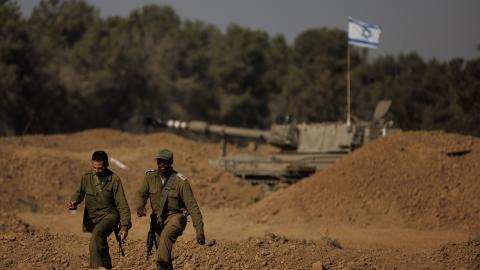Three Things about the Israel-Hamas War is a new series from the Hudson Center for Peace and Security in the Middle East. Every week, Hudson Senior Fellows Michael Doran, Can Kasapoğlu, and Jonathan Schachter will each offer an analysis of one thing—and one thing only—that is of particular importance to understand the Israel-Hamas war. Subscribe here.
Read their analysis below.
1. Israel is winning.
For the first time since October 7, I am cautiously optimistic that Israel will win this war—with winning defined as the successful achievement of its stated aim of destroying Hamas as both a military organization and as the ruling party in Gaza. I am optimistic for five reasons.
First, the country is more united than it has been since 1973. The morale of its fighting forces is high. All indicators suggest that its troops are motivated to do whatever it takes to win, and that society backs them wholeheartedly. While the Israeli press can’t put aside its vendetta against Prime Minister Benjamin Netanyahu, the rest of the country has set aside political differences until the war is over.
Second, the ground incursion is progressing well. While dozens of Israeli soldiers have died in Gaza, the expectation before hostilities commenced was that losses would be even heavier. No one knew for certain how effective Hamas and Palestinian Islamic Jihad would be at exploiting the advantage of their extensive tunnel systems, and many observers feared the worst. As it turns out, the Israelis have largely nullified the tunnel advantage. How? We don’t know. A fascinating story will eventually emerge.
Third, Europe has not turned against Israel as badly as the anti-Israel demonstrations raging in European capitals might suggest. While large protests have erupted in some surprising places, Europe’s governments have not backed away from Israel. German Chancellor Olaf Scholz, for example, said recently that he opposes a ceasefire. “That would mean ultimately that Israel leaves Hamas the possibility of recovering and obtaining new missiles,” he explained.
Fourth, Iran seems content to harass Israel without going all in on major offensive operations. The attacks coming from Hezbollah and the Houthis are certainly no small thing, but they are not significant enough to change the strategic calculus of any of the conflict’s major actors.
Fifth, President Joe Biden seems to have relaxed some of the pressure he had been placing on the Netanyahu government to commit to a ceasefire. “I think we need a pause [in the fighting],” the president said publicly on November 2. He conveyed the same message to Netanyahu personally on November 7. Since then, however, he has backed away from that demand.
But for how long? If a full-blown war with Hezbollah erupts, the United States might feel compelled to press for a ceasefire, allowing Hamas and Hezbollah the space to turn up the heat at will.
— Michael Doran
2. The Houthi threat to Israel is greater than you might think.
So far, Israel has successfully intercepted the drones and missiles launched at it by the Houthis in Yemen, using its own strategic defensive weapons systems and the US Navy’s sea-based air- and missile-defense deterrent. Recently, Israel’s fifth-generation F-35I combat aircraft intercepted a cruise missile, and the US Arleigh Burke–class destroyer USS Carney stopped a drone and missile volley. Israel’s Arrow 2 baseline defensive weapons system also made its combat debut against a ballistic missile, intercepting one that Houthis launched toward the Israeli city of Eilat.
Yet while the activation of the Arrow system is reason to celebrate, the Houthis’ missile launch provides cause for concern. The Iran-backed militants were able to fire a medium-range ballistic missile with a range of 1,600 kilometers (roughly 990 miles), a record distance for an Iran-produced weapon in the Middle East during wartime. That the Houthis launched a ballistic missile, with its massive combat payloads and high homing velocity, rather than a cruise missile or loitering munition, also portends trouble.
Unfortunately, the Houthis’ launch was the culmination of years of preparation. In 2022 and 2023, Iran showcased its advanced missiles during military parades in Yemen. Tehran has been putting Israel in its crosshairs for years.
Protecting population centers against ballistic missiles is like trying to survive in the ring against Mike Tyson: to avoid catastrophe one must duck or parry near-constant attacks, while all Tyson needs is to land a single punch. Israel faces enormous pressure to intercept every ballistic missile launched from Yemen, while all the Houthis need to affect the balance of power is one lucky strike.
But no defensive strategic weapons system—neither Israel’s Arrow nor the United States’ Terminal High Altitude Area Defense (THAAD), which protects the United Arab Emirates and will soon protect Saudi Arabia—can maintain perfect interception rates. At some point, they all let a missile through.
What does all this mean for Israel? The threat it faces from Yemen is greater than many might think. While the American presence in the Middle East may have deterred Hezbollah from launching a full-scale offensive action, it is uncertain how significantly the Houthis will be deterred. Left unchecked, Houthi capabilities could pose a serious threat.
— Can Kasapoğlu
3. Pro-Hamas demonstrations in US cities and on college campuses present President Biden with a Charlottesville moment.
In May, the White House released its National Strategy to Counter Antisemitism. The document opens with a letter from President Biden, in which he writes that the antisemitic 2017 “Unite the Right” rally in Charlottesville, Virginia, spurred him to run for president. He makes specific mention of the torch-carrying marchers at that rally who chanted, “Jews will not replace us.”
Yet for several weeks, in the streets of major American cities and on university campuses across the country, pro-Hamas demonstrators—invariably described as “pro-Palestinian”—have called for the mass murder of Jews.
One of their most common rallying cries, “From the river to the sea, Palestine will be free!”—which the House of Representatives censured Michigan Representative Rashida Tlaib for echoing last week—is merely a rhyming reiteration of the antisemitic, genocidal doctrine of Hamas. The slogan is a mirror image of the Charlottesville marchers’ hateful chant, with the unmistakable meaning, “We will replace Jews.”
On November 4, thousands of demonstrators filled the streets outside the White House, calling for an intifada—which means they want to restart and expand a campaign of suicide bombings and other attacks that killed over 1,000 Israelis. Demonstration leaders shouted praises of Palestinian “martyrs” and the “resistance,” and threatened members of Congress and the media with criminal prosecution.
President Biden has rightly, forcefully, and unequivocally condemned Hamas and the October 7 terrorist assault that it led. He has repeatedly affirmed Israel’s obligation to defend itself and has rejected calls for a ceasefire that would leave Hamas in power and Israeli hostages suffering in Gaza.
But Biden and his administration have said almost nothing about the Americans supporting Hamas, its genocidal goals, and its murderous methods. This is a Charlottesville moment. Will it spur him to act?
— Jonathan Schachter


















